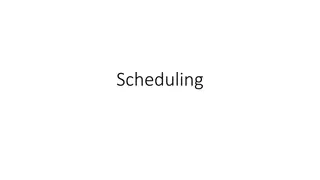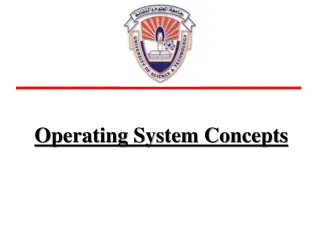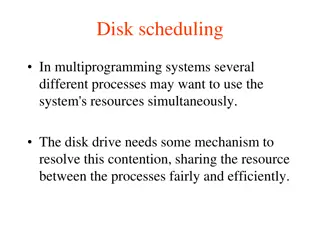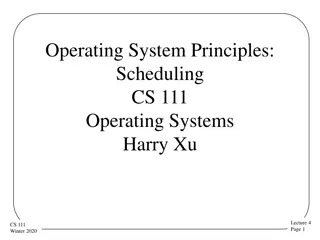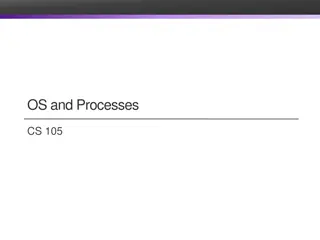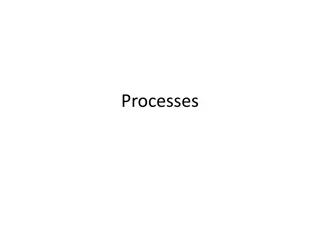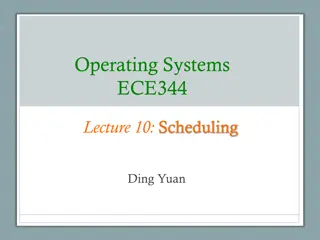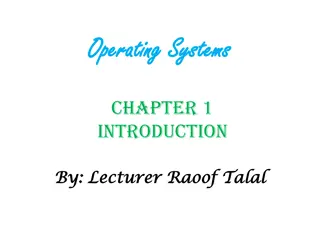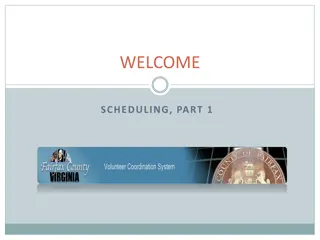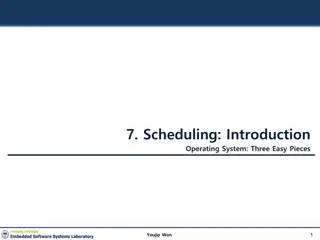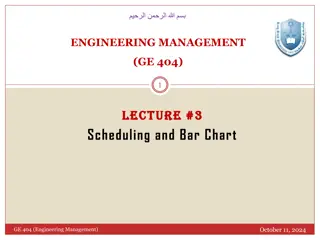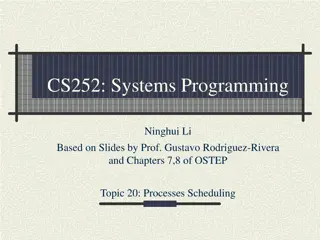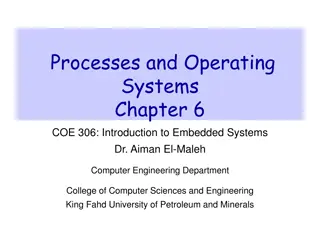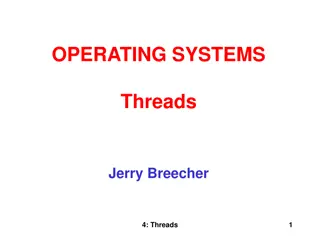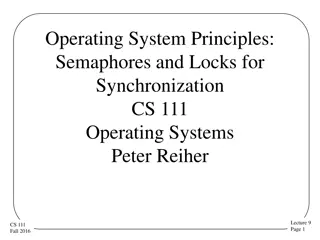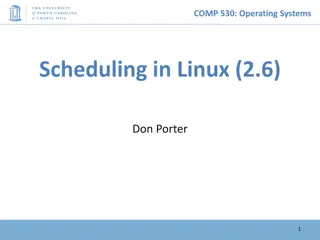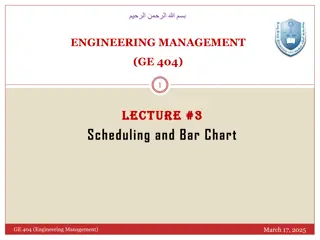Operating Systems Scheduling Processes Overview
Operating systems manage processes through Process Control Blocks (PCBs) stored in memory. The scheduler decides when to switch processes and which to run next based on various criteria. Evaluation criteria include CPU utilization, throughput, turnaround time, waiting time, response time, and fairness. Different scheduling policies aim to optimize CPU usage, throughput, response time, waiting time, and system resource efficiency. The goal is to balance performance metrics while ensuring fairness and efficiency in process execution.
Download Presentation

Please find below an Image/Link to download the presentation.
The content on the website is provided AS IS for your information and personal use only. It may not be sold, licensed, or shared on other websites without obtaining consent from the author.If you encounter any issues during the download, it is possible that the publisher has removed the file from their server.
You are allowed to download the files provided on this website for personal or commercial use, subject to the condition that they are used lawfully. All files are the property of their respective owners.
The content on the website is provided AS IS for your information and personal use only. It may not be sold, licensed, or shared on other websites without obtaining consent from the author.
E N D
Presentation Transcript
ENGINEERING MANAGEMENT (GE 404) 1 LECTURE # LECTURE #10 Cash Flow Analysis 10 March 16, 2025 GE 404 (Engineering Management)
Contents 2 Objectives of the present lecture Introduction Terminologies Cash Flow: Cash in and Cash out Most common types of construction contracts Contract cash flow curves Financial Charges Simplified approach to forecast contract revenue/income curve Simplified approach to forecast contract cost/expense curve Problem Further reading March 16, 2025 GE 404 (Engineering Management)
Objectives of the Present lecture 3 To discuss the fundamentals of cash flow analysis To explain the steps involved in drawing the contract cash flow curves March 16, 2025 GE 404 (Engineering Management)
Introduction 4 As with any businesspersons, contractors are primarily concerned with making money in their businesses. The decisions they make in preparing for and running each of their projects are inevitably related to costs and income. The application of resources (materials, workforce, and machines) relates directly to another resource, money. CPM provides a means for relating time and money. March 16, 2025 GE 404 (Engineering Management)
Terminologies 5 Bid:to offer to do work or provide a service for a particular price French firm will be bidding for the contract. Tender: a formal offer to do work at a stated price A local firm submitted the lowest tender Disbursement:the process of paying money; an amount of money paid There have been delays in the disbursement of funds Retainage:Portion of a contract's final payment withheld by a principal (client or owner) until the project is complete in all respects Lien: the right to keep somebody s property until a debt is paid Markup: an increase in the price of something based on the difference between the cost of producing it and the price it is sold at an average markup of 10% The markup on food in a restaurant is at least 100%. March 16, 2025 GE 404 (Engineering Management)
Cash Flow 6 A cash flow analysis is an investigation of a project in which the focus is on the flow of money. Thus Cash flow refers to a contractor's income and outgo of cash. The net cash flow is the difference between cash out and income at any point in time. A positive cash flow is when the cumulative revenues exceed the cumulative expenditures (meaning that surplus cash is available) A negative cash flow can also occur, and this means that more money is being spent than received. A negative cash flow will mean that the firm will need to take the appropriate steps to borrow from within the firm or financial institutions to cover the shortfall in funds. March 16, 2025 GE 404 (Engineering Management)
Factors that Minimize Contractors Negative Cash Flow 7 Front end rate loading: earlier items in bill of quantities carry a higher mark-up than later items. This reduces negative cash flows in contract early stages Reduction of delays in receiving revenue Adjustment of work schedule to late start timing Coinciding the timing of delivery of large materials orders with the submittal of the contractor's monthly pay estimate Delay in paying labor, plant hirers, materials suppliers, and subcontractors. This would reduce negative cash flows but undermine commercial confidence in the company Increasing the mark-up and reducing the retentions Increasing advance payment Achievement of maximum production in the field Quick settlement of claims March 16, 2025 GE 404 (Engineering Management)
Cash in 8 Owner shall make progress payments of the contract amount to the prime contractor as the work progresses Cash in = Cash receipt = income Principal components of cash in Value of work actually performed in the field Material stored on the site, but not yet incorporated into work, as well as any prefabrication or pre assembly work that the contractor may have done at some location other than the job site A step curve is used to represent contract cash income An income is the actual receipt of revenue. Contract revenue and income curves March 16, 2025 GE 404 (Engineering Management)
Cash Out 9 Cash out = payment of costs = expense An expense is the actual payment of costs. Principal components of cash out Up-front" costs = initial expenses = start-up costs are costs necessary to start the project such as costs of moving in workers and equipment; erecting field offices, storage sheds, fences; job layout; installation of temporary electrical, water, telephone, sanitary, and other services; bonds; permits and project insurance. Payment of direct job costs. These include costs associated with payrolls, materials, equipment, and subcontractor payments. Payments for filed overhead expense and tax. An S-curve (a smooth curve) is used to represent contract cash out. Contract cost and expense curves March 16, 2025 GE 404 (Engineering Management)
Most Common Types of Construction Contracts 10 A construction contract is an agreement that outlines the way a construction job is executed and the specific amount of compensation for the job. Unit price contract This contract type is based on anticipated quantities of items which are counted in the project in addition to their unit prices. The final price of the project depends upon the quantities required to carry out the work. Generally, this contract is suitable only for construction and supplier projects which involve accurate identification of different types of items, but not their numbers, in the contract documents. Lump sum contract Under this contract type, the engineer or contractor agrees to perform the specified and described project for a fixed price. This type of contract is also referred to as a Fixed Price Contract . A Lump Sum or Fixed Price contract is appropriate where scope and schedule of the project are defined sufficiently thus allowing the contractor or engineer to estimate the costs of the project. March 16, 2025 GE 404 (Engineering Management)
Contd. 11 Cost plus contract The cost plus contract is an agreement which involves the buyer s consent to pay the complete cost for material and labor in addition to the amount for contractor overhead and profit. This contract type is favored where the scope of work is highly uncertain or indeterminate in addition to the types of labor, material, and equipment being similarly uncertain in nature. Incentive contracts The incentive contracts feature compensation based on the contracting and/or engineering performance in accord with an agreed target schedule, quality, and budget. Incentive contracts commonly fall into one of two common categories: Fixed Price Incentive Contracts and Cost Reimbursement Incentive Contracts. Percentage of construction contracts This contract type is common for engineering contracts. The compensation involved in these contracts is based on a percentage of the cost of construction. March 16, 2025 GE 404 (Engineering Management)
Payment request for unit price contract 12 The quantities of work done on unit-price contracts are determined by actual field measurement of the bid items put into place. The total quantity accomplished to date on each bid item is multiplied by its corresponding contract unit price. All of the bid items are totaled and the value of materials stored on the site as well as any prefabrication or pre assembly work that the contractor may have done at some location other than the job site is then added. The prescribed retainage is subtracted from this total. The resulting figure represents the entire amount due to the contractor for his work to date. The sum of all prior progress payments that have already been paid is then subtracted, this yielding the net amount of money payable to the contractor for his work that month. March 16, 2025 GE 404 (Engineering Management)
Payment request for lump sum contract 13 Under lump sum contract the project is divided for payment purposes into relatively few work classifications (major job components). Contracts progress is measured in terms of estimated percentages of completion of work classifications. The contractor estimates the percentage completed and in place. The total value of each work classification is multiplied by its percent completion. To the total of completed work is added the value of all materials stored on the site. From this total is subtracted the retainage. This gives the total amount of money due to the contractor (up to the date of the pay request). Form this is subtracted the amount of progress payments already made. The resulting figure gives the net amount now payable to the contractor. March 16, 2025 GE 404 (Engineering Management)
Payment Request for Negotiated (e.g. Cost-Plus) Contract 14 Negotiated contracts of the cost-plus variety usually provide for the contractor's submission of payment vouchers to the owner at specified intervals during the life of the contract. The contractor must make periodic accountings to the owner for the cost of the work, either to receive direct payment form the owner or to obtain further advances of funds. A common provision is weekly reimbursement of payrolls and monthly reimbursement of all other costs, including a proportion of the contractor's fee. March 16, 2025 GE 404 (Engineering Management)
Contract Provisions that Impact Cash in 15 Advanced payment Progress payment Materials stored on the site Final Payment Retention . March 16, 2025 GE 404 (Engineering Management)
Retainage or Retention 16 A prescribed percentage of each progress payment is usually retained by the owner in accordance with the terms of the contract The retainage may be held by the owner until the work receives final certification by the A/E, the owner accepts the project Final payment is then made to the contractor, including the accumulated retainage March 16, 2025 GE 404 (Engineering Management)
Final Payment 17 After the work has been finalized and all deficiencies remedied, the owner makes formal written acceptance of the project and the contractor presents his application for final payment Under a lump-sum form of contract, the final payment is the final contract price less the total of all previous payment installments made With a unit-price contract, the final total quantities of all payment items are measured and the exact final contract price is determined. Final payment is again equal to the contract price less the sum of all progress payments previously made In all cases, final payment by the owner includes all retainage that has been held by him March 16, 2025 GE 404 (Engineering Management)
Cash Flow Forecasting 18 A determination of the future rates of cash outs and cash income together with their combined effect on the project cash balance is called a "cash flow forecast" Cash flow forecasting is required to determine whether or not the funds to execute the plan are available. Cash flow forecasting is the forecasting of both cash in and cash out of the project. Forecast of cash flow is required: To determine the negative cash flow and how to cover it To determine the positive cash flow and how to use it (the positive cash flow of one contract may be used to handle the negative cash flow of another) March 16, 2025 GE 404 (Engineering Management)
Simplified Approach to Forecast Contract Cash Flow (Contract Revenue/Income Curve) 19 1. Produce an activity schedule in bar chart or time-scaled form. Determine the value/price of each activity per week 2. Find the monthly revenue 3. Adjust the revenue for advanced payment and retention 4. Draw cumulative adjusted revenue versus time curve 5. Shift the above curve by the lag between submitting payment requests and receiving revenue to get the income curve March 16, 2025 GE 404 (Engineering Management)
Simplified Approach to Forecast Contract Cash Flow (Contract Cost/Expense Curve) 20 When the mark-up is uniformly spread throughout the contract, the cost/expense curve can be derived as follows: If the mark-up; M, is expressed as a percentage of tender price, then: Cumulative cost = cumulative revenue (1- M) 1. Draw cumulative cost versus time curve 2. Group cost headings that have the same payment delay between incurring the cost and making the payment 3. Calculate the proportion of costs due to each group 4. Shift the cumulative cost of each group by the specified amount to get its cumulative expense 5. Sum up contract cumulative expenses 6. Draw cumulative expense curve March 16, 2025 GE 404 (Engineering Management)
Contract Cash Flow Curves 21 Having determined the contract cumulative income and expense curves, one can combine them on one graph to represent the contract cumulative cash flow curves The difference between contract cumulative income and expense curves can be drawn to represent the contract cumulativenet cash flow March 16, 2025 GE 404 (Engineering Management)
Financial Charges 22 The cash invested in the contract is represented by the negative area between the expense and income curves. This area, A, can be calculated in units of SR. weeks if the vertical scale is in Saudi Riyal and the horizontal scale in weeks. If the rate of investment is r% per year, then the financial charges can be calculated as follows: Financial charges = A r / 52 It is important to point out that if the contractor borrows the negative cash with interest, then r equals the interest rate. March 16, 2025 GE 404 (Engineering Management)
Note 23 Cost = Price (1- M) Price = Cost (1+M) Cost/Price = 1-M Price/Cost = 1+M M is in fraction (e.g. 20% in fraction will be 0.2) March 16, 2025 GE 404 (Engineering Management)
The following network shows the activities of small project. The activities durations are in weeks. The price of each activity is shown in below table. According to contract conditions, the contractor will receive advanced payment of 20%. This will be deduced from each monthly revenue. Applications of payments will be submitted by the contractor to the client every 4 weeks and payment will be after 2 weeks from the submission of the application. The client will deduct 10% from each payment as retention. All retentions will be paid to the contractor with the last payment. The ratio between project price to project cost is 1.1 (project price /project cost = 1.1). There is no delay in paying the costs by the contractor. Calculate and draw the cash flow curves (cash- in and cash-out) based on early start time. Problem-1 3 24 March 16, 2025 GE 404 (Engineering Management)
Solution =161 20%*161 32.2 10%*161 (72-.1*72- .2*72) 32.2 (72/1.1) 25 March 16, 2025 GE 404 (Engineering Management)
32.2 32 82.6 95 128.1 135.46 161 146.37 Income Cost 32.73 65.45 124.55 146.37 32.2 -0.53 -33.25 -62.8 -41.95 -52.86 -18.27 -18.27 -12.4 -7.36 14.63 Solution (Contd.) To get the cost in each week distribute the monthly cost evenly over 4 weeks. For example, Cost after 2 weeks from the start will be: 65.45/4*2=32. 73. 26 March 16, 2025 GE 404 (Engineering Management)
The actives involved in a small engineering project are given in the table. The value of the work involved in each activity is listed in the table. Problem-2 The mark-up is 10% of tender value and is assumed to be uniformly distributed over the contract. The contractor will receive an advanced payment of 10% of tender value. This will be deduced from each monthly revenue. Retention is 5% and is paid on contract completion. Labor cost is assumed to be 30% of total contract cost. The delay for other payment is one month. 7 5 E 3 12 5 4 B 3 9 11 4 H 3 15 ES D A TF EF -2 -1 7 11 10 15 14 18 LS LF Revenue is received after 4 weeks from submitting invoices 0 5 A 0 5 11 4 F 0 15 6 5 C 0 11 18 2 J 0 20 +1 0 5 11 15 6 11 18 20 Assume all the activities are scheduled on their early start timings 10 6 G 1 16 5 5 D 1 10 15 3 I 0 18 11 17 6 11 15 18 Derive income and expanse curve and contract cash flow curves. 27 March 16, 2025 GE 404 (Engineering Management)
Solution 28 (24- .1 24- .0.05 24) March 16, 2025 GE 404 (Engineering Management)
Sample Mid Month expense Calculations =[(72.54-32.67)/4] 2+32.67= 52.605 =(72.54-32.67)/2+32.67= 52.605 Similarly =(137.7-114.21)/2+114.21=125.96 Similarly =(144-137.7)/2+137.7=140.85 Sample Cash flow Calculations: 16-6.48=9.52 16-32.67=-16.67 36.4-72.54=-36.14 29 March 16, 2025 GE 404 (Engineering Management)
Activity Time (weeks) 1 6 2 6 3 6 4 6 5 6 6 7 8 9 10 11 12 13 14 15 16 17 18 19 20 21 22 23 24 A B C D E F G H I J 5 5 3 3 5 3 3 5 5 3 3 5 3 3 5 3 3 5 5 4 3 2 4 3 2 4 3 2 4 3 2 3 3 3 3 3 2 2 Weekly Revenue Monthly Revenue Advanced Payment Retention Adjust. Revenue Cumulative revenue Cumulative Income Cost Cumulative Cost Cumulative labour cost Cumulative other cost Cumulative expense Net Cash Flow 6 6 6 6 6 8 11 16 41 16 11 11 14 52 9 9 9 6 3 3 2 2 24 33 10 16 8 20.4 36.4 34.9 71.3 36.4 36.90 58.50 17.55 15.12 32.67 -16.67 3.73 44.2 115.5 71.3 46.80 105.30 31.59 40.95 72.54 -36.14 -1.29 28.1 143.5 115.5 29.70 135.00 40.50 73.71 114.21 -42.96 1.24 8.5 160.0 143.5 9.00 144.00 43.20 94.50 137.70 -22.25 5.80 16 16 160.0 21.60 21.60 6.48 100.80 144.00 -0.50 16.00 6.48 9.52 16 Sample Mid Month expense Calculations =[(72.54-32.67)/4] 2+32.67= 52.605 =(72.54-32.67)/2+32.67= 52.605 Similarly =(137.7-114.21)/2+114.21=125.96 Similarly =(144-137.7)/2+137.7=140.85 Sample Cash flow Calculations: 16-6.48=9.52 16-32.67=-16.67 36.4-72.54=-36.14 30 March 16, 2025 GE 404 (Engineering Management)
Problem-3 The following Time scaled network shows the activities of a small engineering project. The cost of each activity is shown in the table below. 1 2 3 4 5 6 7 8 9 10 11 12 13 A B C D G H E F Activity A B C D E F G H Total cost 10000 25000 10000 5000 15000 5000 7500 15000 The contractor will receive advance payment of 15% of the project price. This will be deducted from each monthly revenue. Application of payment will be submitted by the contractor to the client every month and payment will be after 4 weeks from the submission of the application. The client will deduct 5% from each payment as retention . All retention will be paid to the contractor with the final payment . Assume the markup is 20% of the total project cost and is uniformly distributed over the work. There is no delay in paying costs by the contractor. Calculate the cash-in and cash-out values and find maximum negative cash flow. 31 March 16, 2025 GE 404 (Engineering Management)
Solution 32 Price = Cost (1+M) ; M:markup= 20%=0.02 Total Activity A B C D E F G H Total cost 10000 25000 10000 5000 15000 5000 7500 15000 92500 Revenue 12000 30000 12000 6000 18000 6000 9000 18000 111000 Advanced payment = 0.15 111000 = 16650 Retention = 0.05 111000 = 5550 March 16, 2025 GE 404 (Engineering Management)
33 March 16, 2025 GE 404 (Engineering Management)
Solution (contd.) 34 March 16, 2025 GE 404 (Engineering Management)
Problem-4 35 The table below lists the cumulative monthly expenses incurred by contractors and the corresponding monthly incomes which are received from the owner of a project. End of Month Cumulative Expense, (1000SR) Cumulative Income, (1000SR) 0 0 0 1 12 0 2 20 0 3 54 0 4 90 14 If the owner makes all his payments one month later than anticipated in the table above, by what percentage will the cash invested (i.e. negative area between the expense and income curves) increase? 5 130 40 6 180 100 7 220 130 8 240 190 9 260 210 10 290 300 11 290 320 12 290 340 March 16, 2025 GE 404 (Engineering Management)
Solution b a c 1 = + ( ) Area c b a a c 2 1 = + ( ) Area a b c 2 Sample Calculation: =0.5(12+20) 1=16 =0.5(20+54) 1=37 =0.5(54+90) 1=72 =0.5(130+90) 1-14 1=96 End of Month 0 0 0 0 1 2 3 4 5 6 7 8 9 10 290 300 65 20 11 290 320 * 80 12 290 340 * Total Cumulative Expense (1000 SR) Cumulative Income (1000 SR) Negative Area Additional Negative Area 12 0 6 20 0 16 54 0 37 90 14 72 130 40 96 14 180 100 115 26 220 130 100 60 240 190 100 30 260 210 60 60 667 290 957 290 = = Increase % negative in area 100 43 5 . % 667 36 March 16, 2025 GE 404 (Engineering Management)
Further Reading 37 Read more about the Cash-flow from: Jimmie W. Hinze. Construction Planning and Management, Fourth Edition, 2012, Pearson. March 16, 2025 GE 404 (Engineering Management)
Thank You 38 Questions Please March 16, 2025 GE 404 (Engineering Management)



